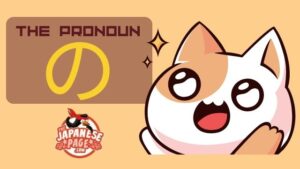Mastering the Japanese の: Its Use as a Dependent Indefinite Pronoun and Beyond
Japanese is filled with fascinating language features that might be a tad challenging to grasp but are incredibly satisfying once you do.
Today, we're going to shine the spotlight on one extremely handy particle: の. While many often know it as a "possessive particle", it actually wears many more hats!

One of its key roles, and our focus for today, is its use as a dependent indefinite pronoun. So, grab a cup of お茶, settle in, and let's explore this together!
Using の as a Dependent Indefinite Pronoun
First, what is a "dependent indefinite pronoun"?
Short answer: It's like the "one" in "I want the big one."
Longer answer: The term "dependent indefinite pronoun" might seem a bit daunting at first glance, but it refers to a straightforward grammatical concept.
Let's break it down:
- Pronoun: A pronoun is a word that takes the place of a noun in a sentence. For example, in the sentence "John is tall, and he is also smart," "he" is a pronoun that stands in for "John."
- Indefinite: An indefinite pronoun refers to a noun that is not specifically identified. This could be because it's unspecified, unknown, or irrelevant. Examples in English include words like "someone," "anything," "nobody," and "everything."
- Dependent: A dependent pronoun is one that must be used in relation to an antecedent, which is a word or phrase it refers back to. For example, in the sentence "John bought a book, and he likes it," "he" refers back to "John," and "it" refers back to "book." These pronouns depend on their antecedents for their meanings.
So, a "dependent indefinite pronoun" is a pronoun that stands in for an unspecified or not explicitly mentioned noun, and its meaning depends on an antecedent or context. In Japanese, 'の' often plays this role, standing in for a noun that has been mentioned or implied earlier, just like "one" in the English sentence "I want the red one" where "one" stands for an unspecified object, understood from the context.
Consider the sentence,
安いのが欲しい
I want the cheap one.
Here, の stands in for an unspecified object that's understood from context. In English, this translates to "I want the cheap one." 安い is an adjective meaning "cheap", が is the subject marker of the phrase, and 欲しい means "want". So, の is used to denote the "cheap one" that the speaker desires.
Another example is
大きいのを買った
I bought a big one.
This means "I bought a big one." 大きい means "big", を is the object marker, and 買った is the past tense of 買う, which means "to buy". Here, の is referring to the "big one" that was purchased.
In these instances, の smoothly replaces a noun without making the sentence feel repetitive or unwieldy. It's also worth noting that の can stand in for both singular and plural nouns, depending on the context.
How to use:
Simply use it in replace of a noun. This technique is especially useful to avoid repeating the same word over and over again.
安い車が欲しい ➟ 安いのが欲しい
I want a cheap car. ➟ I want a cheap one.
Just remember the context should make it clear we are speaking about a car (in this example).
Other Uses of の
While its role as a dependent indefinite pronoun is crucial, の also plays other pivotal roles in the Japanese language.
- Possessive Particle: This is perhaps the most common use of の. It shows a relationship of possession or belonging between two nouns, equivalent to 's or "of" in English. For example, 彼の本 translates to "his book", where の signifies possession.
- Attributive Particle: の is also used to modify a noun with another noun, acting like an attributive particle. For instance, in 日本の音楽, meaning "Japanese music", の links 日本 (Japan) and 音楽 (music), attributing the music to Japan. You can also think of this as a "limiting" particle. It limits the information: it isn't just any music, but "Japanese" music.
- Sentence-Ending Particle: In informal speech, の can be used at the end of sentences to indicate a question or explanation, making the sentence sound more explanatory or inquisitive. For example, それは何なの means "What is that?"
- Nominalizer: の can turn a verb or an adjective into a noun. For instance, in 走るのが好き, meaning "I like running", の nominalizes 走る (to run).
Wrapping Up
In essence, の is an essential multifaceted tool in the Japanese language that you will encounter frequently. The usage that we've focused on in this article, its function as a dependent indefinite pronoun, is a great way to make your Japanese more fluent and natural. It allows you to express yourself succinctly and avoid unnecessary repetition, making your conversations more engaging and smooth.
Remember that understanding the context is key when using の as a dependent indefinite pronoun. It often replaces a noun that has been previously mentioned or is understood from the situation. Practice using の in different contexts, and soon, you'll find it to be an indispensable part of your Japanese language repertoire.
Aside from this, の also serves as a possessive particle, attributive particle, sentence-ending particle, and a nominalizer. Each usage has its unique rules and nuances, and mastering these will significantly enhance your grasp of the language.
In your journey to learn Japanese, remember that consistent practice and real-life application are the most effective ways to solidify your understanding of complex particles like の. Try to use の in different situations and contexts, and don't be afraid to make mistakes. After all, every error is a stepping stone to mastering the language (as long as you learn from your mistakes --so ask people to correct you)!
So, you see の is not just a simple possessive particle. It is a versatile linguistic element that brings a lot of depth and flexibility to Japanese expressions. With practice and patience, you'll be using の like a native speaker in no time!






Just super clear and very pleasant way of explaining ! Bravo !!
This was great explanation! Thanks!
Great! Glad it helped.
Very detailed and very useful presentation of the particle “no” in everyday’s speech and from the grammatical point of use. I’m suggesting you to send similar presentations/lessons in other parts of the Japanese language.
Thanks! I’m glad it helped. I think I will expand this page when I have time to cover all the other functions of の. Thanks for your comment!